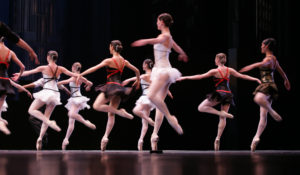Fifteen years ago, Olie Westheimer, executive director of the Brooklyn Parkinson Group approached the Mark Morris Dance Company about creating a dance class for her clients. Dance for PD©, a program training teachers and providing classes for those with Parkinson’s disease, is the result.
The program initially met with skepticism, recalls dancer-developer David Leventhal. Medical doctors felt that dance is “frivolous.” As Leventhal notes, “There is a lot of misconception about the amount of learning and skill and brain work and physical work that somebody has to do to execute a dance.”

Helen Bronte-Stewart, a Stanford professor of neurology and former dancer, agrees. “As physicians, we stress the importance of physical activity, social interaction and mental stimulation to our patients with Parkinson’s disease. Dance for PD gives them all three.”
Here we have the same triumvirate of benefits noted in the research on contra dance and memory – dancing provides cognitive and social stimulation in addition to physical activity. But that is not all.
As Bronte-Stewart continues, dance is more than just physical therapy – “The PD dancers have told us this type of dance restores their self-image and brings them joy.” Immersed in the activity, participants sometimes find they are able to regain function. For example, during a flamenco dance routine, one woman found herself snapping her once-rigid fingers – “it just came to me,” she recalled in amazement.

 In late April we celebrate National Dance Week. This year’s festivities come with scientific evidence that
In late April we celebrate National Dance Week. This year’s festivities come with scientific evidence that  “You must not think of dance as steps,” Rudolf Laban once told a group of student actors. “Dance is meaningful movement. You can dance with your eyebrows. When I have taught you, you will be able to dance with any part of your body.’’
“You must not think of dance as steps,” Rudolf Laban once told a group of student actors. “Dance is meaningful movement. You can dance with your eyebrows. When I have taught you, you will be able to dance with any part of your body.’’ “Effort is visible in the action movement of a worker, or a dancer, and it is audible in song or speech,” Laban observes in
“Effort is visible in the action movement of a worker, or a dancer, and it is audible in song or speech,” Laban observes in  In discussing the actor who is an artist, Laban writes “this kind of performer concentrates on the actuation of the inner springs of conduct preceding his movements, and pays little attention at first to the skill needed for presentation.” In other words, this actor focuses on the inner intention to move.
In discussing the actor who is an artist, Laban writes “this kind of performer concentrates on the actuation of the inner springs of conduct preceding his movements, and pays little attention at first to the skill needed for presentation.” In other words, this actor focuses on the inner intention to move. I launched the new MoveScape Center correspondence course, Mastering Rudolf Laban’s
I launched the new MoveScape Center correspondence course, Mastering Rudolf Laban’s  Lamb affirmed that “effort goes with shape organically.” Yet careful study of an individual’s movement pattern will reveal an emphasis on effort more than shape, or vice versa. Lamb came to feel that this difference was fundamental and significant.
Lamb affirmed that “effort goes with shape organically.” Yet careful study of an individual’s movement pattern will reveal an emphasis on effort more than shape, or vice versa. Lamb came to feel that this difference was fundamental and significant.
 Rudolf Laban’s use of movement-based observational techniques anticipated the notion of “embodied cognition” by several decades. In his writings in the 1940s and 50s, Laban already had identified “mental efforts” — namely those of giving attention to what must be done, forming an intention to act, and finally taking decisive action — as stages of “inner preparation for outer action.”
Rudolf Laban’s use of movement-based observational techniques anticipated the notion of “embodied cognition” by several decades. In his writings in the 1940s and 50s, Laban already had identified “mental efforts” — namely those of giving attention to what must be done, forming an intention to act, and finally taking decisive action — as stages of “inner preparation for outer action.” A Movement Pattern Analysis profile reflects how an individual balances Assertion (the exertion of tangible movement effort to make something happen) with Perspective (positioning oneself to get a better view of the situation). In the pilot study group, some individuals emphasized Assertion, while others favored Perspective.
A Movement Pattern Analysis profile reflects how an individual balances Assertion (the exertion of tangible movement effort to make something happen) with Perspective (positioning oneself to get a better view of the situation). In the pilot study group, some individuals emphasized Assertion, while others favored Perspective.